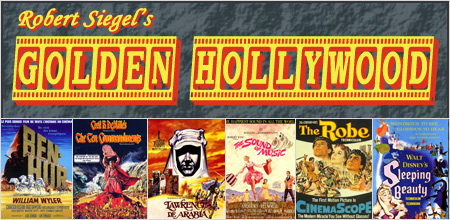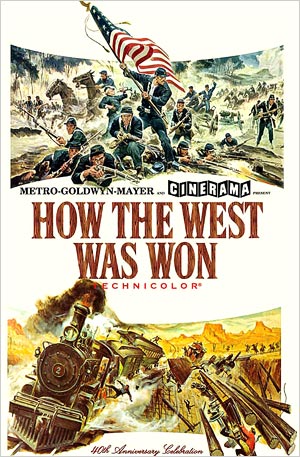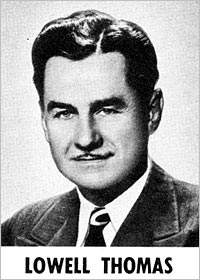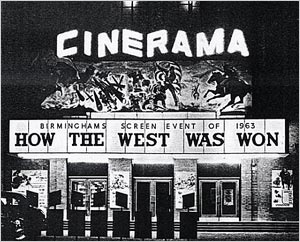 |
Site created 12/15/97.

page created: 9/30/08
 Robert Siegel - Main Page NOTE: The scans below are the property of Robert Siegel and The Digital Bits, and may not be reposted without permission. Copyright of the images belongs to the respective studios. In addition, please note that all the information contained within the text is taken from ORIGINAL studio press materials, which may contain some errors. |
How the West Was Won
Film appreciation by Robert Siegel of The Digital Bits MGM's tremendously successful production in Metrocolor and the Cinerama process, How the West was Won, has been completely remastered and restored for DVD and Blu-ray disc by Warner Home Video. The release of the movie on home video is an event for classic film fans, because for years the film was released in a version showing the connecting lines of the three Cinerama images, in addition to a mediocre transfer. Warner Home Video has given fans a treat with this Digibook set, remastering the film and taking out the lines that were visible in all previous versions. So for the first time, not only is the film available with remastered picture and sound using the latest technology, the lines have been removed and the soundtrack restored. In addition, the Blu-ray Disc contains a Dolby TrueHD lossless track, so fans can hear the soundtrack exactly as it sounds on the master. And for a soundtrack with such a fantastic score and sound effects, this is sure to be a thrill to the viewer and those with affection for the widescreen film processes of the 1950's and 1960's. [Continued below...] |
  |
How the West Was Won was truly a motion picture event. As many as 12,000 players were used in eleven months of filming to bring this outdoor adventure to the screen. Three of Hollywood's most illustrious directors combined their talents and 149 years of motion picture experience in creating this masterpiece. The cast, all playing major roles, was hired from the A-list of Hollywood actors. Never before had such a cast been put together for a single motion picture event. To capture the scope of what the final product was to be, the directors took stars and crews on a literal tour of western America's scenic wonderland. States in which filming took place included Kentucky, Illinois, Oregon, Colorado, South Dakota, California, Arizona, New Mexico and Utah. To realize what a special motion picture this was and why, we first have to look at the special process with which it was first released, "Cinerama." [Continued below...] |

|
Cinerama was the brainchild of Fred Waller, a Brooklyn-born inventor who already had to his credit the invention of water-skis, the remote recording anemometer (a camera that takes a 360 degree picture) and the first photographic printer and timer. It was in 1937, when Walker was head of Paramount's special-effects department, that he first became interested in the possibility of multi-dimensional motion pictures. For some of his studio's film spectacles, he had developed a wide-angle lens. He noticed as he watched the daily rushes that the sequences shot with this lens conveyed a slight suggestion of depth. Deciding from this evidence that the secret of creating the illusion of natural perspective on film was largely a matter of reproducing the actual range of human vision, he began experimenting with a camera that would duplicate not only what the eyes see straight ahead, but also "peripheral vision" - that part of the world around us that we see out of the corners of our eyes. His first camera was really eleven, linked together by an elaborate synchronizing device, each of which photographed a small section of the scene to be shot. When projected from eleven synchronized projectors, these films blended into a mosaic that covered a range 185 degrees wide and 85 high. But the picture was distorted on the conventional flat screen and the range was so wide that Waller found the cameras were photographing each other, creating fuzzy blobs on the fringes of the scene.
[Continued below...] |
  
 |
About this time Ralph Walker, one of New York's most famous architects, asked Waller's help in devising a motion picture exhibit for a project he was designing for the New York World's Fair. The building was the perisphere, and the instant Waller saw the concave spherical surface of the interior he realized that this was the answer to his problem: a curved screen that would reproduce the curved field of vision of the human retina. With this obstacle hurdled, Waller began work on perfecting Cinerama. He had some financial assistance from Walker and, later, Laurence Rockefeller, who turned over the old Rockefeller carriage house in mid-town Manhattan to the inventor as a laboratory. Then came Pearl Harbor, apparently putting an end to the entire project. As it happened, however, Cinerama itself went to war. A Navy ballistics expert, who had witnessed one of the early demonstrations in the Rockefeller stable, wondered aloud if such a device could not be adapted to combat training. Waller thought it could and within a few months had developed the Waller Gunnery Trainer, which was subsequently credited by the Air Force with saving more than 100,000 lives in the skies over Europe and the Pacific. Using a five-lensed camera and five separate projectors (instead of eleven), the elaborate mechanism projected synchronized motion pictures of "enemy" planes on the inner surface of a dome, in front of which was mounted a series of electronically controlled machine guns. The student gunner learned to lead his target in a setting that duplicated not only the visual but also the emotional environment of actual combat.
[Continued below...] |

|
With a new ally in the person of Hazard Reeves, a brilliant electronic engineer who developed the stereophonic sound system that Cinerama employed, Waller moved his quarters from the Rockefeller carriage house to a huge indoor tennis court in Oyster Bay, Long Island, where he began the critical task of perfecting his process for public exhibition. Meanwhile, Waller was busy making test sequences in the new medium and showing them to his friends to gauge public reaction to the process. One of his early shots was the roller coaster ride at Rockaway's Playland which, remade in color, provided the breathtaking opening sequence of the first film, This is Cinerama. Another, designed to dramatize the high-fidelity realism of Hazard Reeves' sound system, was a performance of the Long Island Choral Society singing Handel's Messiah. Many distinguished visitors, including the heads of virtually every major motion picture company, made the pilgrimage to Oyster Bay to see Wally's wonder. Then one day, Lowell Thomas dropped in to see his old friend Hazard Reeves and was invited to look at Cinerama. One glance told him that, in his own words, he was seeing "the motion picture of tomorrow." In a matter of weeks, a production company had been formed and enough capital had been raised to begin shooting the first Cinerama feature. Lowell Thomas called in one of Hollywood's top producers-directors, Merian C. Cooper, and between them they decided to make a picture in which the only hero would be the Cinerama camera.
[Continued below...] |
 Diagram of the Cinerama presentation. |
If Waller could somehow "delimit" the field of vision, narrow it down so that almost the entire 180 degree arc that the human eye can perceive would be concentrated in one area, he could turn the principle of peripheral vision to practical film-making advantage. The shape of the Cinerama screen was Waller's solution to that problem. It covered an arc of 146 degrees - approximately the same as the human eye - and it curved to conform to normal perception of depth. A curving screen posed problems, however. To keep the image uniformly clear at every point, Waller placed on his projectors special lenses of great focal depth. To prevent light from bouncing back and forth from one side of the screen to the other and distorting the images, he devised a revolutionary louvered screen. Although it looks solid from a distance, the Cinerama screen is, in fact, made up of eleven hundred vertical strips of perforated tape, angled like the slats of a Venetian blind that has been set on end. Reflected light bounced off one louvre to the back of the next, which in turn deflects it harmlessly to the rear. Waller's standard Cinerama screen measured 75 feet wide and 26 feet high. The Cinerama camera developed was three cameras in one. Through three separate 27mm lenses - approximately similar to the lens of your own eye - it took three pictures at the same time on three separate rolls of film. Set at 48-degree angles to each other, each lens covered one third of the entire picture, the one on the right photographing the left third, and the one on the center shooting straight ahead. In the theater, the process was reversed. The projectors, grounded in concrete, are locked together by motors that automatically keep the three images in perfect sync on the screen. Waller's most ingenious invention is his device for obscuring the join lines where the images meet. Tiny comb-like bits of steel were fitted into each projector at the side of the film gate. Jiggling up and down along the edges of the film at high speed, they fuzz the edges of the pictures and minimize the lines between them. The first projectionists promptly named them "jiggolos" and the name remained.
[Continued below...] |
 The Pacific Cinerama Dome in Hollywood.  Minneapolis Cinerama theatre "The Cooper" (now demolished). |
Months passed in intense production until at last This is Cinerama was complete. Before it could be shown, however, the Broadway Theater in New York had to be virtually rebuilt to make room for the 75-foot screen and the three giant projection booths. It was also rewired for the elaborate sound system, with its nine huge amplifiers spotted behind the screen and around the auditorium. But at last all was ready. On the evening of September 30th, 1952, a distinguished first night audience took their seats within the compass of the enormous encircling screen. The house lights dimmed and Lowell Thomas' familiar voice spoke three words that would be remembered forever. These words were "This is Cinerama." As the curtains drew back and up to reveal the immensity of the great curving Cinerama screen for the first time, audiences were stunned. Where a moment ago they were looking at Lowell Thomas on a normal screen (normal in size and shape) now they suddenly found themselves engulfed by a king of a movie they had never seen before. Cinerama seemed to have gained its effect by pulling the audience physically into the picture. Before you knew it, you were rocking along in the front car of Cinerama's famous roller coaster ride. It took more that fifteen years and more than three million dollars (a huge sum at the time) to bring in the new medium in 1952 for the first Cinerama film, This is Cinerama.
[Continued below...] |
 
|
After several Cinerama films had been released, including Cinerama Holiday, the head of MGM was very interested in using the system for the first feature film that contained Hollywood stars and a storyline. It had to be a big production, and one that audiences would be interested in seeing. Finally the decision was made to tell the tale of the old West and its development. Months were spent on storyline and hiring the greatest stars of the screen, as MGM planned this to be a major motion picture event. The resulting picture, How the West Was Won, would cost an estimated $15 million dollars, a huge sum for a Hollywood picture at the time. It would go on to gross around $35 million, and $50 million worldwide. Originally, it was shown in the three-panel Cinerama process and then released in regular widescreen 35mm and 70mm Ultra-Panavision 70. Filming began May of 1961, and continued through the end of November of the same year.
[Continued on Page Two...] |
 |
On to Page Two...
 |
| Site
designed for 1024 x 768 resolution, using 16M colors and .gif 89a
animation. © 1997-2015 The Digital Bits, Inc., All Rights Reserved. billhunt@thedigitalbits.com |